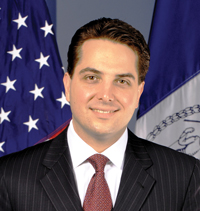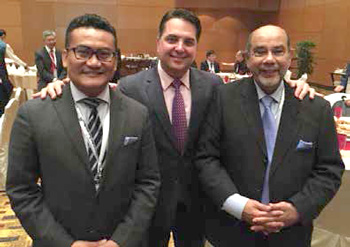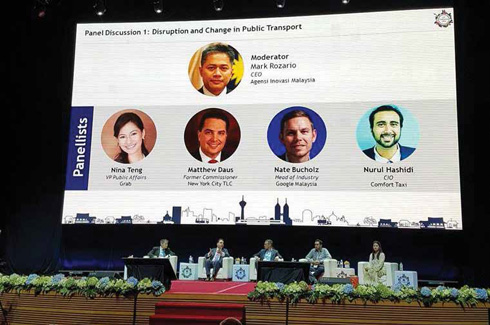 |
IN FOCUS |
|
by Matthew W. Daus, Esq.[1] |
||
I recently returned from a trip to Asia and the Middle East where I stopped over in Malaysia at the request of the government to deliver a speech on Disruption and Change in Public Transport. I met the esteemed Prime Minister of Malaysia, His Excellency Najib Raza; the Chair of the Land Transport Commission (a/k/a SPAD), Dr. Syed Hamid Albar; and spent time with the SPAD CEO, Mr. Mohd Azharuddin Mat Sah and his staff.
I was duly impressed with the Prime Minister who is the only head of state I am aware of who has ever addressed taxi reform. During his speech on the country's transportation plan, he promised a "level playing field" between the taxicab, private hire industry incumbents and new entrants or transportation dispatch network companies. The Prime Minister even has his own app to interface with his constituents nationally and beyond.
The multi-faceted regulatory challenges that arose as a result of the global phenomenon of app based transportation companies require a holistic approach to address them. Regulators around the world have recognized how disruptive these services can be and have introduced varying solutions to address safety and security concerns.
Recently, regulators, including unique multi-modal agencies such as SPAD, have started to embrace a new approach where they attempt to "level the playing field" for all market participants, as well as integrate all transport modes into one transportation ecosystem.
This new approach differs from the traditional silo planning taken by most countries and localities around the world which segregate rail and bus service from paratransit, taxicab, limousine, and freight vehicle licensing.

Professor Matthew W. Daus, Esq. (center) is joined by Malaysia Land Transport Authority, CEO Mr. Mohd Azharuddin Mat Sah (left), and, Chair Dr. Syed Hamid Albar (right), in Kuala Lumpur, Malaysia.
SPAD is working on new regulations known as the Taxi Industry Transformation Program (TITP)[1] expected to go into effect in November 2016. The regulations leverage technology to improve taxi service, improve taxi drivers' incomes by increasing taxi fares, and regulate e-hail service providers.
The new regulations define e-hail apps as an "intermediary service" and mandate companies that offer e-hailing services to be incorporated in Malaysia, and for all e-hail drivers to have their operator's licenses issued by SPAD.
Drivers of e-hail companies will also be required to undergo a new stringent screening process that includes a health check, criminal background check, traffic offense and violation check to determine eligibility.[2] These proposed changes take the safety and security elements of the taxi regulations and apply them to new market participants, including registration and criminal background checks for their drivers.

Moderator: Mark Rozario, CEO of Agensi Inovasi Malaysia; Nina Teng, VP Public Affairs of Grab; Matthew Daus, Former Commissioner of NYC TLC; Nate Bucholz, Head of Industry of Google Malaysia; Nurul Hashidi, CIO of Comfort Taxi.
In 2013, I organized, with the International Association of Public Transport (UITP)[3], a regulatory study tour with SPAD and many other international regulators from Europe, the Middle East and Asia. The "fact finding" trip to New York City and Chicago helped regulators learn first hand the history of taxi and for-hire vehicle regulation.[4]
The International Association of Transportation Regulators and the University Transportation Research Center at CUNY partnered with UITP to provide training sessions and site visits to government agencies and private taxi and for-hire operations. This included Malaysian regulators providing comprehensive background information on best regulatory practices that shaped the new SPAD reforms.
One of the central discussions of the training sessions concerned the 1998 regulatory reforms in NYC which I helped to conceive, draft, pass and implement as General Counsel for the NYC Taxi and Limousine Commission (TLC). This was initiated following reports that crashes involving taxis and other for-hire vehicles increased 50% between 1991 and 1996 and injuries to cabbies, drivers, their passengers, pedestrians and bicyclists skyrocketed 64% during the same period.
The 1998 NYC regulatory reforms required driver drug testing, criminal background checks, driver violations, point systems, probationary licenses, defensive driver training, and higher vehicle insurance that significantly improved taxi service quality.
SPAD's proposed changes are a high priority of the Malaysian government. The Malaysian head of state, Prime Minister Najib Razak, has highlighted taxis as an essential element of the wider mobility network of the country. He called for a comprehensive regulatory strategy that will level the playing field for all market participants.
The Prime Minister noted that the land public transport system and policies must be more commuter centric and responsive to demographic changes, and reaffirmed the commitment of the government to address land public transport needs through holistic and inclusive solutions.[5]

Other jurisdictions are addressing the implications of integrating taxis into the overall urban mobility system. This is in line with recent changes to the transportation eco-system and the anticipated entry of autonomous and semi-autonomous vehicles in the for-hire vehicle sector.
Similar to Malaysia's integrated transportation policy objectives, other jurisdictions, such as Dubai are:
The expected outcome of these transportation master plans, among other things, will include initiatives such as Bus Rapid Transit, emerging autonomous vehicle technology for buses/taxi/marine. The plans will also include new service provisions in the form of demand responsive and other web and app based booking systems. These systems provide a highly customer focused, and service orientated approach to mobility.
With the expansion of data driven transportation service fueled by app companies, regulators will be able to access a significant amount of new data about supply and demand from all modes of transportation. This will create new opportunities for mobility integration.
Among the many benefits of an integrated master plan driven by data is the benefit to cities that manage over crowded transit systems. The plan helps them to identify high demand areas and comparable price points to address excess demand, especially during rush hour. In so doing, other modes of for-hire transit can be integrated with the public transport system.
Regulators need to start thinking about the big picture of an inter-modal transportation system that uses existing technologies to improve transportation service to enable competition with the incumbent industry and other transportation modes on a level playing field.
PlaNYC[6] started a movement where local governments laid out extensive forward thinking plans to be implemented over coming decades to help the enviornment. It is now, due to big data, technology and disruption, presenting an opportunity to expand such initiatives to create smart cities with urban transport plans that collect and analyze data to deliver all local services better.
On the transportation planning side, countries like Malaysia and cities like Dubai envision not just sustainability, but full multi-modal integration spurred on by technology like high speed rail, smartphone apps and connected autonomous vehicles.
Cities, states and countries develop master infrastructure, land use and transportation plans that include "smart city" approaches to data collection and analysis. It also includes integration and coordination or consolidation of many government agencies working together towards a common urban plan to address expanding city population.